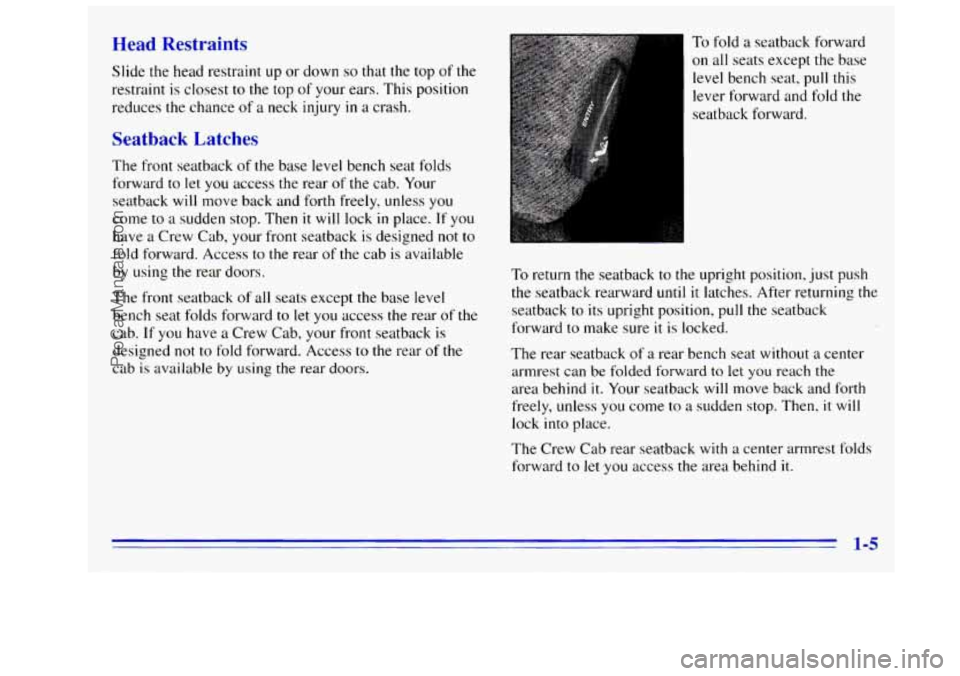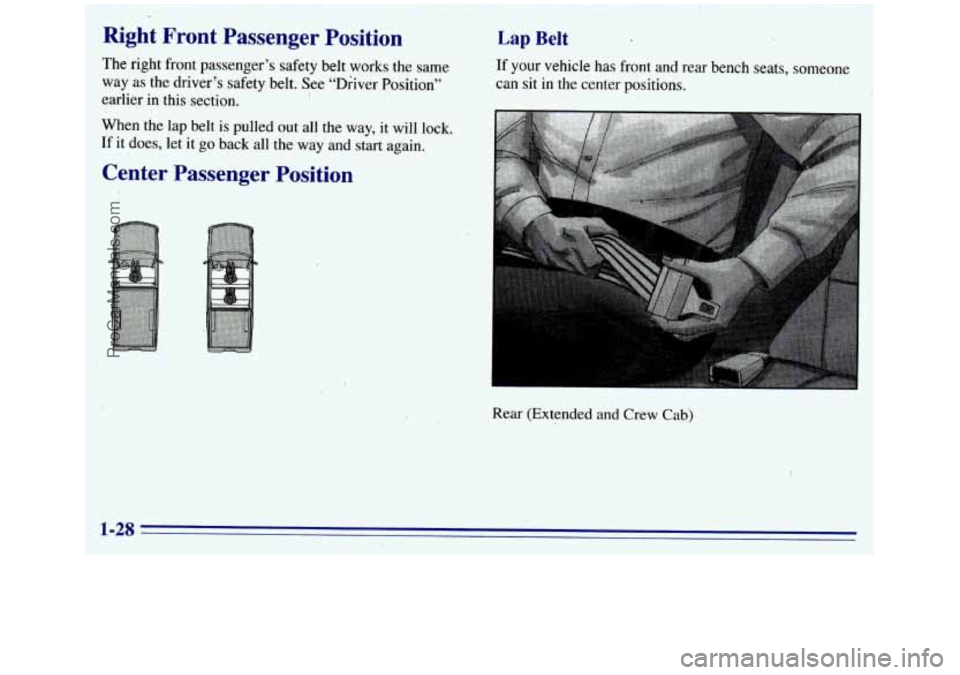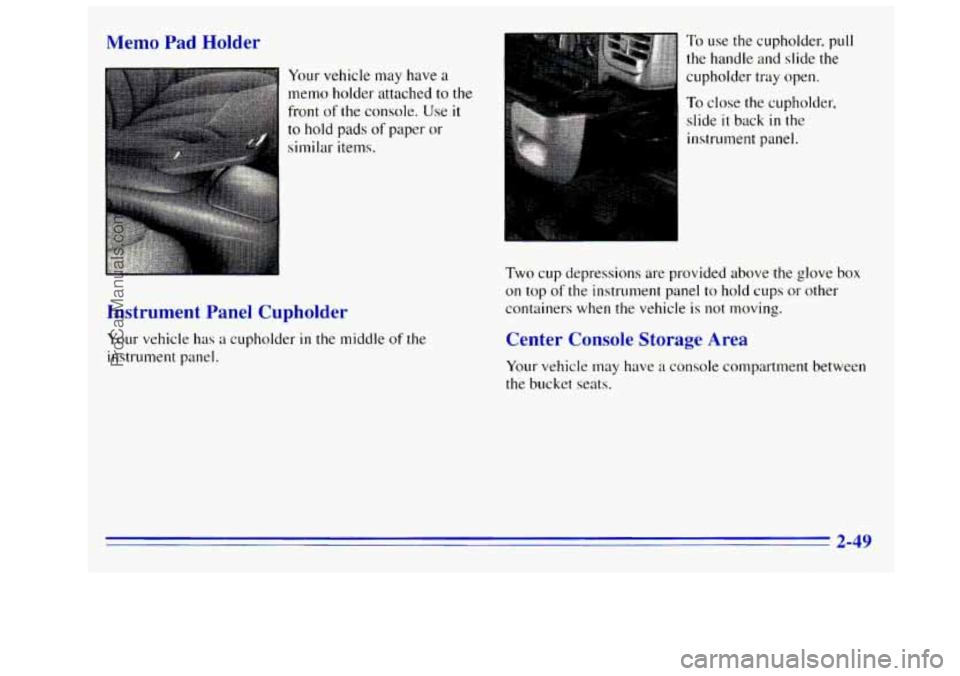1996 GMC SIERRA seats
[x] Cancel search: seatsPage 3 of 404

The 1996 GMC Sierra Owner’s Manual
Seats and Restraint Systems ............................................................. 1-1
This section tells you how to use your seats and safety belts\
properly. It also explains the “SIR” system.
Features and Controls .................................................................. 2-1
This section explains how to start and operate your vehicle.
Comfort Controls and Audio Systems ..................................................... 3-1
This section tells you how to adjust the ventilation and comfo\
rt controls and how to operate your
audio system.
Here you’ll find helpful information and tips about
the road and how to drive under different conditions.
This section tells you what to do if you have
a problem while driving, such as a flat tire or overheated
engine, etc.
Here the manual tells you how to keep your vehicle running properly and looking good.
This section tells you when to perform vehicle maintenance and \
what fluids and lubricants to use.
This section tells you how to contact
GMC Truck for assistance and how to get service and owner
publications.
It also gives you information on “Reporting Safety Defects’’ on page 8-8.
Here’s an alphabetical listing of almost every subject in this manual. You can use it to quickly find
something you want to read.
YourDrivingandtheRoad .............................................................. 4-1
ProblemsontheRoad .................................................................. 5-1
Service and Appearance Care ............................................................ 6-1
MaintenanceSchedule......... ......................................................... 7-1
Customer Assistance Information ........................................................ 8-1
Index ........................................................................\
........ 9-1
ProCarManuals.com
Page 9 of 404

Section 1 Seats and Restraint Systems
Here you’ll find information about the seats in your
vehicle and how to use your safety belts properly.
You
can also learn about some things you should not do with
air bags and safety belts.
Seats and Seat Controls
This section tells you about the seats -- how to adjust
them, and fold them
up and down. It also tells you about
reclining front seatbacks and head restraints.
Mar--a1 Front Seat
CAUTION:
You can lose control of the vehicle if you try to
adjust
a manual driver’s seat while the vehicle is
moving. The sudden movement could startle and
confuse you, or
make you push a pedal when you
don’t want to. Adjust the driver’s seat only when
the vehicle
is not moving.
If your vehicle has a manual
bucket, split bench
or full
bench seat,
you can adjust it
with this lever at the front
of the seat.
~
I
Slide the lever at the front of the seat toward the
passenger’s side to unlock
it. Using your body, slide the
seat
to where you want it. Then, release the lever and try
to move the seat with your body
in order to make sure
the seat
is locked in place.
1-1
ProCarManuals.com
Page 13 of 404

Head traints
Slide the head restraint up or down so that the top of the
restraint is closest
to the top of your ears. This position
reduces the chance
of a neck injury in a crash.
Seatback Latches
The front seatback of the base level bench seat folds
forward to let
you access the rear of the cab. Your
seatback will move back and forth freely, unless
you
come to a sudden stop. Then it will lock in place. If you
have a Crew Cab, your front seatback is designed not to
fold forward. Access to the rear of the cab is available
by using the rear doors.
The front seatback of all seats except
the base level
bench seat folds forward
to let you access the rear of the
cab.
If you have a Crew Cab, your front seatback is
designed
not to fold forward. Access to the rear of the
cab is available by using the rear doors.
To fold a seatback forward
on all seats except the base
level bench seat, pull this
lever forward and fold
the
seatback forward.
To return the seatback to the upright position, just push
the seatback rearward
until it latches. After returning the
seatback
to its upright position, pull the seatback
forward to make sure
it is locked.
The rear seatback
of a rear bench seat without a center
armrest can be folded forward
to let you reach the
area behind it. Your seatback will move back and forth
freely, unless you come
to a sudden stop. Then, it will
lock into place.
The Crew Cab rear seatback with a center armrest folds
forward to let.you access the area behind
it.
ProCarManuals.com
Page 21 of 404

&.’ If I’m a good driver, and I never drive far from
A: You may be an excellent driver, but if you’re in an
home, why should I wear safety belts?
accident -- even one that isn’t your fault -- you and
your passengers can be hurt. Being a good driver
doesn’t protect
you from things beyond your
control, such as bad drivers.
Most accidents occur within
25 miles (40 km) of
home. And the greatest number of serious injuries
and deaths occur at speeds of less than
40 mph
(65 km/h).
Safety belts are for everyone. First, you’ll
want
to know which restraint systems your
vehicle has.
We’ll start with
the driver position.
Driver Position
This part describes the driver’s restraint system.
Lap-Shoulder Belt
The driver has a lap-shoulder belt. Here’s how to wear it
properly.
1. Close and lock the door.
2. Adjust the seat (to see how, see “Seats” in the Index)
so you can sit up straight.
How to Wear Safety Belts Properly
Adults
This part is only for people of adult size.
Be aware that there are special things to know about
safety belts and children. And there are different rules
for
smaller children and babies. If a child will be riding in
your vehicle, see the part of this manual called
“Children.” Follow those rules for everyone’s protection.
1-13
ProCarManuals.com
Page 36 of 404

.
Right Front Passenger Position
The right front passenger’s safety belt works the same
earlier in this section.
When the lap belt is pulled out all the
way, it will lock.
If it does, let it
go back all the way and start again.
, way as the driver’s safety belt. !See “Driver Position”
Center Passenger Position
Lap Belt
If your vehicle has front and rear bench seats, someone
can sit
in the center positions.
Rear (Extended and Crew Cab)
1-28
ProCarManuals.com
Page 111 of 404

Memo Pad Holder
Your vehicle may have a
memo holder attached to the
front of
the console. Use it
to hold pads of paper or
similar items.
Instrument Panel Cupholder
Your vehicle has a cupholder in the middle of the
instrument panel.
To use the cupholder, pull
the handle and slide the
cupholder tray open.
To close the cupholdel-,
slide
it back in the
instrument panel.
Two cup depressions are provided above the glove box
on top of the instrument panel to hold cups or other
containers when the vehicle is not moving.
Center Console Storage Area
Your vehicle may have a console compartment between
the bucket seats.
2-49
ProCarManuals.com
Page 135 of 404

Ventilation Tips
Your vehicle has air outlets in the center and on the sides
of your instrument panel. You can move the outlets from
side to side or up and down to direct the
flow of air, or
close the outlets altogether. When
you close an outlet, it
will increase the flow of air coming out of any outlets
that are open. These outlets do not completely
shut off
airflow when
in the closed position.
0
0
0
Keep the hood and front air inlet free of ice, snow or
any other obstruction (such
as leaves). The heater
and defroster
will work far better, reducing the
chance of fogging the inside
of your windows.
When you enter
a vehicle in cold weather, turn the
blower fan to HI for a few moments before driving.
This helps clear the intake ducts
of snow and
moisture, and reduces the chance
of fogging the
inside
of your windows.
Keep the air path under the front seats clear
of
objects. This helps air to circulate throughout
your vehicle.
Defogging and Defrosting
On cool, humid days, use DEFOG to keep the
windshield and side windows clear.
Use DEFROST
to remove fog or ice from the windshield in extremely
humid or cold conditions. Use DEFROST
with the
temperature knob toward
the red area and the fan control
toward
HI.
ProCarManuals.com
Page 197 of 404

Do not load your vehicle any heavier than the
GVWR, or either the maximum front or rear
GAWR. If you do, parts on your vehicle can break,
or it can change the
way your vehicle handles.
These could cause you to lose control. Also,
overloading can shorten the life of your vehicle.
NOTICE:
Your warranty dose not cover parts or
components that fail because
of overloading.
If you put things inside your vehicle -- like suitcases,
tools, packages, or anything else
-- they go as fat as the
vehicle goes. If you have to stop or turn quickly, or if
there is a crash, they’ll keep going.
CriUTdN:
r
Things you put inside your vehicle can strike
and injure people in
a sudden stop or turn, or
in
a crash.
0 Put things in the cargo area of your vehicle.
Try to spread the weight evenly.
Never stack heavier things, like suitcases,
inside the vehicle
so that some of them are
above the tops
of the seats.
0 Don’t leave an unsecured child restraint in
your vehicle.
When you carry something inside the
vehicle, secure it whenever you can.
0 Don’t leave a seat folded down unless you
need to.
There’s also important loading information for off-road
driving
in this manual. See ”Loading Your Vehicle” in
the Index.
ProCarManuals.com